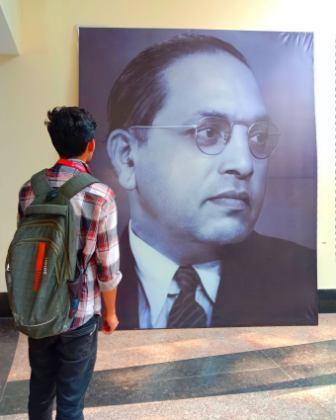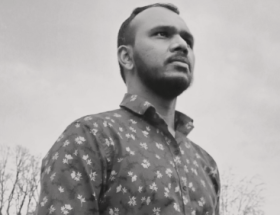Sankalp Gaikwad
It has been approximately 2,563 years since the Buddha attained enlightenment and 66 years since Bodhisattva Dr. Babasaheb Ambedkar set the Dhamma Chakra in motion. Yet, within our society, a distinct phenomenon has emerged—a species. This species manifests primarily during Brahmanical festivals and remains conspicuously absent during Islamic or Christian celebrations. It exhibits a peculiar affinity for Hindu festivals, celebrating them under the guise of secularism. This phenomenon is widely recognized as “Pseudo-Ambedkarism,” and in the following article, we shall undertake an in-depth examination to ascertain its authenticity across three distinct dimensions: religious, social, and political.
Religious
In recent days, I have observed many Hindu Dalits who, while publicly professing Ambedkarism, actively promote Brahminical culture within their homes, workplaces, schools, and hostels. This occurrence, though not novel, poses moral quandaries. Maharashtra boasts numerous individuals, ranging from political leaders and actors to local activists, who lay claim to Ambedkar’s legacy. Paradoxically, they partake in festivals like Holi, Ganesh Chaturthi, and Diwali, transmitting mixed messages to the younger generation.
For instance, a Buddhist actor extends earnest greetings on Bhim Jayanti, so seriously that it seemed as though his voice had the seriousness of speaking about someone’s death, and the same actor celebrates a Hindu festival, then he opens his heart, seemingly liberated from shackles. It is important to acknowledge the individual liberty granted within Dhamma, as both Buddha and Babasaheb emphasized such freedom, unmatched in other religions. However, it appears that our community occasionally misuses this liberty. These festivals, rather than fostering enlightenment, tend to perpetuate a state of blind submission to Brahmanical hegemony.
Moreover, by perpetuating the Brahminical culture that historically subjugated them, our people keep their minds confined and function as willing servants to the same forces that once enslaved them. However, during occasions like Bhima Koregaon, Bhim Jayanti, Buddha Purnima, and Ashok Vijayadashami, we witness a transformation. Dalits align with Buddhism, don the mantle of Ambedkarism with ease, and proudly brandish the blue flag alongside the Panchsheel flag. This exemplifies the era of Pseudo-Ambedkarism.
We do not advocate stringent adherence to Buddhism or the exclusion of practices outside its purview. Within the realm of Dhamma, we do not impose mandates but rather guide individuals toward a virtuous path that minimizes suffering and fosters righteous deeds. Bodhisattva Babasaheb’s 22 vows are not strict rules but guiding principles. Following them consistently proves beneficial and mitigates adverse consequences.
A stark illustration of ongoing caste-based discrimination occurred recently when a Buddhist youth was brutally assaulted in Maharashtra’s Latur district for dancing during Ganpati Visarjan. This affirms that, despite appearances in metropolitan areas, casteism persists. As long as the upper castes assert their dominance, the lower castes remain in their shadow.
To eradicate this deep-rooted inequity, we must embark on a distinct path, In a 1936 speech, Babasaheb articulated, “Caste is a state of mind. It is a disease of the mind. The teachings of the Hindu religion are the root cause of this disease. We practise the casteism, we observe the Untouchability, because we are asked to do so by the Hindu religion in which we live. A bitter thing can be made sweet. The taste of salty and astringent things can be changed. But the poison cannot be made nectar (Amrit!) To talk of annihilating castes while living in the Hinduism is like talking of changing the poison into nectar (Amrit). In short, so long as we remain in the religion which teaches a man to treat other man as filthy, the sense of discrimination on account of caste which is deeply rooted in our minds, cannot be abolished. For annihilating the castes and the Untouchability from among the Untouchables, change of religion is the only antidote.” Our duty is to enlighten every individual, for the counteraction of the 22 vows instills within us a sense of rebirth, reaffirming our distinct identity and culture beyond the confines of Hinduism. To understand this topic in more depth, I further quote Tejaswini Tabhane, an Ambedkarite Buddhist student activist; she writes, “Babasaheb died as a Buddhist, and that is a historical fact one cannot and must not avoid. Babasaheb took refuge to Buddha and called him his Master, who taught him his basic principles of life that he followed in the cause for social justice. It’s definitely one’s choice to follow Buddha’s Dhamma or not. Even Buddha wouldn’t ask you to follow him unless your mind told you to do that. But one cannot separate Babasaheb from Buddha. You can choose not to follow him in embracing Buddhism, but there’s no ‘secular’ Babasaheb that exists.”
Social
When examining the post-Ambedkar era, it’s evident that Ambedkarite activists had a strong presence in the late 70s and 80s. Bodhisattva Dr. Babasaheb Ambedkar envisioned a Prabuddha Bharat—a nation characterized by scientific, compassionate, and rational values. However, regrettably, there was a lack of substantial movements during this period, failing to disseminate the principles of Buddha widely. This stands as one of our shortcomings.
Nevertheless, in response to escalating atrocities and the fervor of young individuals, a new confrontational era emerged, personified by groups like the Dalit Panthers, led by figures such as Raja Dhale, Namdev Dhasal, Bhai Sangare, and J.V. Pawar. This ushered in an aggressive, militant chapter in Ambedkarite Buddhist literature, an unexpected development. The Dalit Panthers exerted considerable influence for a short period. However, ideological differences and, notably, Raja Dhale’s assertion that Marxism and Ambedkarism couldn’t coexist marked a turning point.
Raja Dhale boldly asserted that Marxism wouldn’t effectively address our issues, emphasizing Babasaheb’s counsel to adhere to their Buddhist ideology and methods. The path of Buddhism, although long, seemed the most assured. At the time, there was a wave of ideas; there were differences among themselves, but today it seems to be flawed. Individuals, regardless of their ideological inclinations, often appear detached from their beliefs. They engage in daily routines, occasionally reacting to inhumane acts through social media posts. Paradoxically, these same individuals may simultaneously celebrate and endorse Brahminical culture, reflecting a phenomenon characterized as the era of pseudo Ambedkarism.
Once talking to The Caravan, Indu Chaudhary, an Ambedkarite thinker, made a good analysis of Pseudo-Ambedkarism. I quote it hereby: “It doesn’t matter whose government it is; if your ideology is strong, then you will always be strong. Today, Bahujans are getting weaker because their ideology has weakened. They have mixed it up. This is the era of Pseudo-Ambedkarism, and it is dangerous. The ideology that is contradictory to Manyavar Kanshiram’s is called Manuwadi ideology. You cannot take them both along. Manyavar Kanshiram talked about how caste order and social distinctions should be eradicated. What is that distinction based on? It is based on the Varna system. Babasaheb tried to end this superstition and hypocrisy, but he failed. Then he made 22 vows before adopting Buddhism. It was simple: if you want to align with this ideology, then you have to break away from it. The generation that was the first to adopt [Ambedkarite] Buddhism gradually died out. It is the third generation now. And this generation is watching everything through media and television, and somehow, that [Manuwadi] ideology starts spreading.”
This group can be characterized as lacking in formal education, while the more educated segment has advanced beyond them by a significant margin, as follows:
Scheduled Castes Buddhists actively promote Buddhism and Ambedkarism on odd days, but on even days, they often struggle financially and become Dalits. There’s an internal hierarchy within the SCs—socially Dalit, politically Dalit, and economically Dalit. If this persists, even religious Dalits may arise.
Many NGOs bear Babasaheb’s name, but they often prioritize money over spreading his true teachings, hindering their impact. Some neo-intellectual classes among Dalits, like bureaucrats and professionals, focus solely on reservations and neglect Ambedkarism. They prefer their old caste labels instead of embracing Buddhism.
The emergence of a pseudo-rich class among Dalits benefiting from reservations poses a threat to Ambedkarite ideas, as they prioritize wealth over spreading his message. This class within the caste could have actually worked for the spread of Ambedkarite ideas, but they are busy enjoying the pseudo-rich culture and transferring it to their children.
Labeling Bodhisattva as Mahar/Chamar creates unnecessary caste divisions. Babasaheb, when struggled, never struggled for Mahars, but he struggled for Untouchables as a whole. Why divide our savior on the lines of caste within caste? Blindly worshipping Babasaheb as a deity goes against his philosophy. He foresaw this and didn’t want to be elevated to godlike status. Few individuals prioritize sociopolitical ideology over economic pursuits due to the lure of commercialization and economic growth. This ideology is agitational in nature, demanding time and financial sacrifices and often requiring people to put aside their personal lives. Therefore, dedicated individuals to carry this mission forward daily are scarce.
Political
In contemporary discourse, there is an emerging perspective advocating for the secularization of politics, urging a departure from entrenched ideological stances. Concurrently, some critics pose a poignant question regarding the fidelity to the principles of the 22 vows by Adv. Prakash Ambedkar and Sujat Ambedkar. This scrutiny underscores a prevailing concern regarding the authenticity of political adherence to the Ambedkarite ethos.
Indeed, a nuanced analysis reveals the prevalence of what can be termed ‘Pseudo-Ambedkarism’ within a spectrum of political systems, including the Bharatiya Janata Party, Indian National Congress, Nationalist Congress Party, Shiv Sena, Communist Party of India, and all socialist factions. This phenomenon underscores the disillusionment with parties that, ostensibly, lay claim to Ambedkarite principles but often fall short in their commitment. The perplexing aspect lies in the continued association of Ambedkarite individuals with these diverse political entities. One may conjecture that this affiliation arises from either personal motivations, such as self-interest or ambition, or the altruistic aspiration to disseminate Ambedkarite values among broader segments of society. Discerning the exact motivations behind this affiliation, however, remains a complex and elusive endeavor.
To gain a more profound comprehension of this subject, I am inclined to seek elucidation from an article authored by journalist Prasanna Joshi. He conducted a detailed analysis of the political landscape in Maharashtra and has authored an article that focuses on the rise of the Vanchit Bahujan Aghadi (VBA) and its leader, Adv. Prakash Ambedkar. In his article, Joshi underscores that Balasaheb Ambedkar has brought a fresh perspective to Ambedkarite politics, challenging conventional political norms. He notes that while this political movement has traditionally maintained its unique identity, Balasaheb Ambedkar has recognized the necessity of mainstream acceptance to gain political prominence, a shift that previous parties like the Congress, Left, Communist, and Socialist groups had overlooked.
Joshi highlights the significance of the OBC and Hindu backward class society as the foundation of Hinduism and Hindutva. He suggests that if the effort to make Ambedkar a leader within the Hindu community succeeds, it could prove to be a fruitful experiment.
Furthermore, Joshi emphasizes that Balasaheb Ambedkar’s personal choice of Buddhism should not be a point of contention, as diverse religious expressions exist within politics. He draws parallels to instances like the celebration of Durga Puja in Bengal under communist rule and Sharad Pawar’s leadership, demonstrating that religious beliefs or practices should not be politicized or held against Balasaheb Ambedkar. Joshi argues that those who want to criticize Balasaheb Ambedkar, recalling the 22 vows, should also note that acknowledging and respecting are two different things. The darshan of Vitthal is part of paying respect. Just as any tolerant religious person would respect Gautama Buddha. Also, Adv. Ambedkar’s choice of deity Vitthal for agitation is part of a different cultural understanding.
In the larger context, Joshi asserts that Balasaheb Ambedkar has the potential to disrupt the political landscape in Maharashtra, bridging divides that have existed for decades between parties like Congress and the NCP on the left and the Sena-BJP on the right. He believes that Balasaheb Ambedkar’s ideological foundation, rooted in the principles of Buddhism, provides him with powerful tools for political influence without the need for significant ideological shifts. He underscores that those who have made such ideological leaps throughout their lives can learn from Balasaheb Ambedkar’s approach. Ultimately, Joshi paints a picture of a changing political landscape in Maharashtra, where Adv. Prakash Ambedkar’s influence is set to play a pivotal role, highlighting the juxtaposition of various ideologies and practices within the state’s politics.
Between 1956 and 1978, despite changing times, Scheduled Castes (SCs) remained politically and economically marginalized, facing societal acceptance issues and fearing extinction. Selfishness and greed caused divisions. From 1978 to the early 21st century, caste-based atrocities persisted, with movements against them. However, except for the Buddhist community, most SCs continued to lack access to education, political influence, and socio-economic progress. To change this, we must strive to establish 21st-century Ambedkarism, which requires building our own political and economic strength. Ambedkar’s ideas are gaining global recognition, but misinterpretations and underestimations persist, particularly in the upper-caste-dominated Indian media. Therefore, we have to take this chariot of equality forward, and Dhammachakka needs to be rotated vigorously in order for it to move even faster. I would like to conclude that Babasaheb’s final words, “Educate, Agitate, Organize,” are based on Buddhist philosophy. These commandments must be kept in this order. I have seen a lot of Pseudo-Ambedkarites who used a different order by changing the second commandment (Agitate) to the third and changing this order to Educate, Organize and Agitate. By doing this, it goes along the lines of Marxism. It’s important for Ambedkarites worldwide to follow this order and experience it: Educate, Agitate, Organize.
Bibliography :
What Way Emancipation? Speech delivered by Dr. Ambedkar to the Bombay Presidency Mahar Conference, 31st May 1936.
Roundtableindia.co.in Dalits and dichotomy of the Ganesh festival by Kavita Choha.
Tejaswini Tabhane, an Ambedkarite Buddhist student activist.
Caravanmagazine.in interview of Dr. Indu choudhary (BHU) Bahujan Shakti Mission.
Academia.edu Ambedkarism Relevance in Present Indian Society by Dr. Sanjay K Bhasin.
Inmarathi.com Question raised on Prakash Ambedkar with vitthala statue by Journalist Prasanna Joshi.
~~~
Sankalp Gaikwad holds a Bachelor’s degree in Political Science from the University of Mumbai. His keen interests lie in the domains of politics and Buddhist studies.










